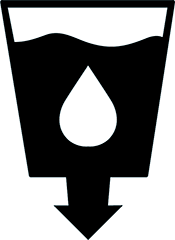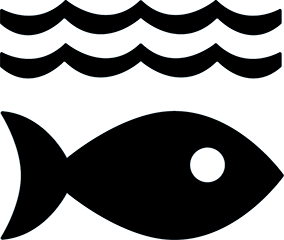UN Sustainable Development Goals Addressed
-

Goal 2: Zero Hunger
-

Goal 3: Good Health & Wellbeing
-

Goal 6: Clean Water & Sanitation
-

Goal 14: Life Below Water
2021 Global Design Challenge Finalist
This design concept was developed by participants in the Institute’s Global Design Challenge. The descriptions below are from the team’s competition entry materials.
Location: Taipei, Taiwan
Team members: Shu-Yao Chang, Yi-Wen Chen, Po-HungChung, Nian-Hao Chen, Wei-Cheng Lin
Innovation Details
24-hour water quality monitoring is key in reducing illegal dumping of toxic heavy metal pollution, and yet it’s expensive and requires significant power supply. MicroBergy is an economical, sustainable, self-powered water quality monitor that generates electrical signals from the pollutants in wastewater. Inspired by the curve of a shark tail fin, the sea snail’s shell spiral, sea anemones’ electrodes, and the barnacle’s shape, the design mimics these forms and then uses bacteria to generate the electrical signals that make this technology self-powered. Without the restrictions of expense and power supply, MicroBergy can be installed in places where existing 24-hour water quality monitors cannot, increasing the capacity for monitoring water quality and illegal dumping of toxic pollutants.
Define the problem being solved. Approximately 80% of wastewater flows back to the ecosystem without treatment and illegal wastewater dumping is one of the major reasons. The problem we are trying to solve is the global, illegal heavy metal wastewater dumping. Toxic, heavy metal pollution caused by human beings mainly comes from industrial, mining, and agricultural activities. Pollution can reduce grain production, cause damage to human health, decrease clean drinking water, and increase heavy metal concentration in marine life. 24 hour water quality monitoring is crucial to reduce illegal dumping. However, the existing 24 hour water quality monitor is expensive (500-1,000 USD per set) and requires power supply. With these two main restrictions, 24 hour water quality monitor cannot be widely installed, leading to lower monitoring capacity and more illegal wastewater dumping. MicroBergy is an economical (10-30 USD per set) sustainable, self-powered water quality monitor, which can generate electric signals from the pollutants in wastewater.
What organisms/natural systems helped inform this design? There is one biological strategy and four biomimicry strategies that inspired this design. The team used a technology called Microbial fuel cell (MFC), which utilized bacteria to decompose organic substrates to generate electric signals and become self-powered. The top turbine mimicking the curve of a shark tail fin can turn water flow from different directions into a rotational force and drive the inner spiral to spin. The inner sea snail design spiral can create a vortex and increase wastewater flow exchange. The protrusion of the sea anemones’ design on the surface of electrodes of MFC can increase the contacting area with wastewater and improve the generating efficiency. The overall shape of a barnacle can fix stably and secretly under the water.
What does this design do? There are three layers in MicroBergy. At the top of the device is the shark-tail-fin design turbine made of aluminum alloy which is connected with the inner sea-snail design spiral. The anguilliform of shark-tail-fin can turn the water flow from different directions into rotational force efficiently and can further drive the inner sea-snail spiral to create vortex.Together, they can increase wastewater exchange between the microbial fuel cell(MFC) and the outer water flow. The second layer of MicroBergy is the MFC, which is divided into three spaces. Two side spaces act as the anode and the central one acts as cathode. The team pre-cultured special heavy metal reduction bacteria biofilm on graphite electrodes. When the bacteria is exposed to toxic heavy metal ions, it will be damaged and generate less electricity. It can then be speculated that the fast recovery of electric signals as the presence of heavy metal ions. By increasing the contacting area of electrodes through sea-anemone design, the team can increase generating efficiency and improve sensitivity of the device. The overall shape of barnacle design made of polylactide plastic can fix stably and secretly under the water. The inclined plane can reduce the force from water flow; the large base area to fix itself on different surfaces with underwater glue; and the rock-like appearance can hide itself in surroundings. At the bottom locates the bioenergy and signal conditioning panel, which is separated from the water and can transfer electricity generated from MFC into wireless signal. The wireless signal will then be collected by the wireless hub a few meters away , which is powered by a 10 cm2 solar panel. The wireless hub can finally upload heavy metal wastewater electric signals to the online database, allowing illegal wastewater dumping monitoring and further analysis.
How does this solution address the problem or opportunity? Without the restrictions of expensiveness and power supply, MicroBergy can be widely and largely installed at the places where the existing 24 hour water quality monitor cannot, which can increase the water quality monitoring capacity of the government. Moreover, the wastewater electric signals stored in the database can be analyzed to depict wastewater flow distribution and routes and predict the location of the source of heavy metal wastewater. Thus, it can decrease illegal heavy metal wastewater dumping. By doing so, MicroBergy can protect farmlands from being polluted (SDG 2), prevent human beings from drinking heavy-metal-polluted water (SDG 3 and SDG 6), and decrease the heavy metal concentration in marine life (SDG14).
Element: How compatible is this design with all surrounding living systems? Is it safe? How is it more sustainable than the alternatives? From the aspect of material, the body of MicroBergy is made of polylactic acid plastic, which is durable under normal temperature and decomposable under higher temperature; the electrodes of microbial fuel cell are made of graphite, which is non-toxic and environmental friendly; the top turbine connected with inner spiral is made of aluminum alloy, which is not only light but also nearly 100% recyclable. Together, the materials of MicroBergy are not only safe but also sustainable. From the aspect of design, MicroBergy can monitor water quality without the need of power supply, which allows it to work more sustainably and independently compared to the existing monitor. Furthermore, since MicroBergy is rather small (9cm x 14cm) and low-key in color, it can hide easily in the environment with high compatibility.
(Re)connect Element: Describe how this innovation helped the team connect with the natural world. The team learned how to observe and ask nature questions from different aspects. Through observing nature, the team was able to come up with several ideas to create a device that is compatible with microbial fuel cell. For example, instead of phrasing a question as “how to increase contacting area in limited space?”, the team asked: “how does nature increase exchanging efficiency?” Secondly, the team found out that nature already has the most efficient solutions. Before starting the brainstorming out of nowhere, it will always be more efficient and effective to first go straight to nature. The team repeated this process four times and came up with four biomimicry designs. Surprisingly, nature can always provide a decent solution.
How were Nature’s Unifying Patterns or Life’s Principles applied to this design? MicroBergy shows the value of two of life’s principles, including “Be Resource Efficient (Material and Energy)” and “Be Locally Attuned And Responsive”. Through generating electricity from decomposing pollutants by microbial fuel cell system, MicroBergy indeed is resource efficient, utilizing something considered as waste to provide electricity for water quality monitoring. Through generating different patterns of electric signals when being exposed to different pollutants (organic pollutants and heavy metal ions), MicroBergy is locally attuned and responsive. Moreover, by cultivating bacterial biofilm on the electrodes, MFC of MicroBergy can be even more sensitive and durable at the same time since biofilm can increase the transmission of electrons and provide protection for bacteria against the environment.

